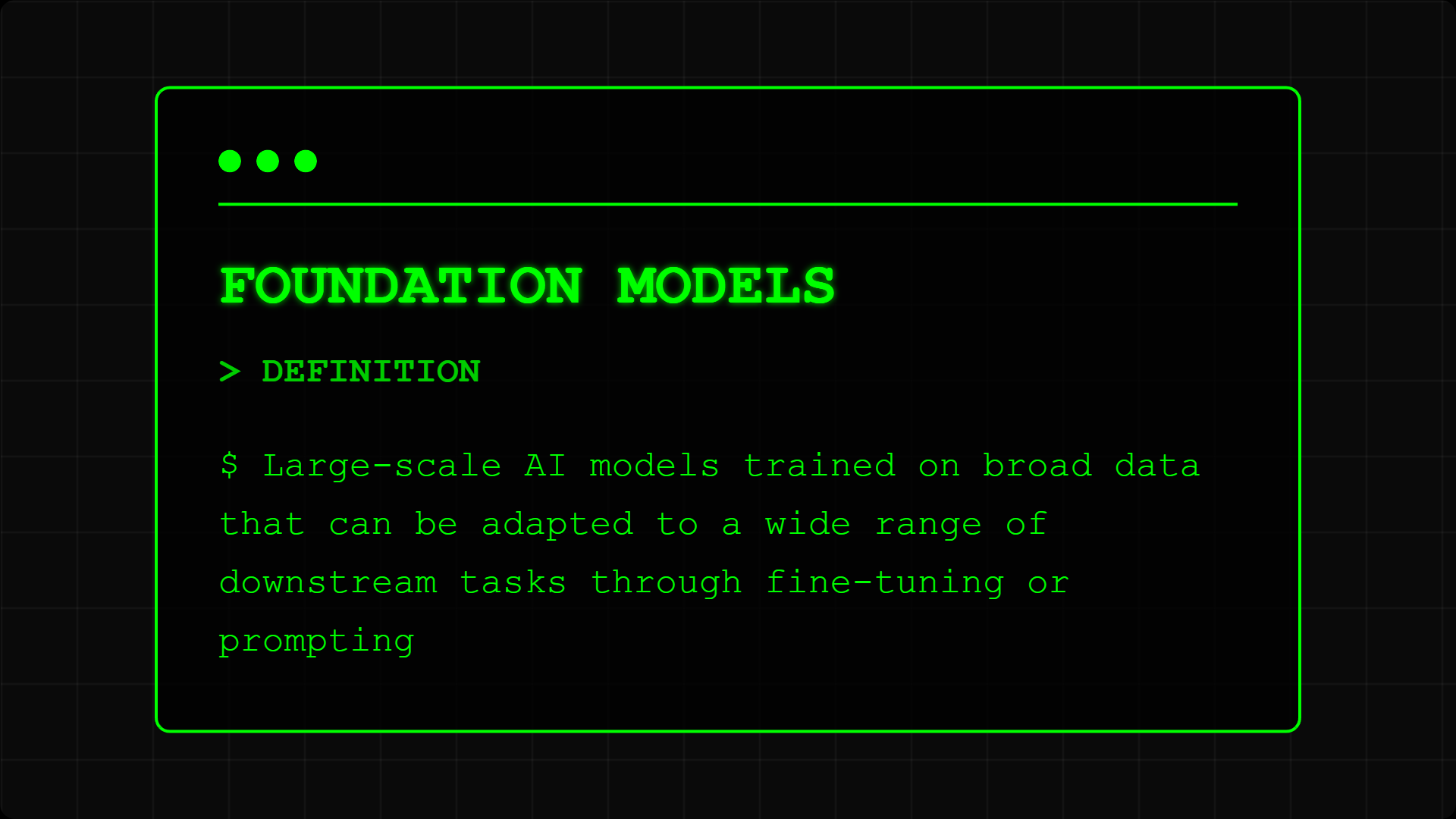AI Terms
What are Foundation Models? The AI Infrastructure Revolution

Why can the same AI write poetry, analyze spreadsheets, and code websites? Foundation models—massive AI systems trained on vast data that can be adapted for virtually any task. They're the reason AI suddenly works for everything.
The Paradigm Shift in AI
The term "foundation model" was coined by Stanford researchers in 2021 to describe a fundamental shift in how AI systems are built. Instead of training separate models for each task, one massive model serves as the foundation for countless applications.
Stanford's Center for Research on Foundation Models defines them as "models trained on broad data at scale that can be adapted to a wide range of downstream tasks, forming the foundation upon which many applications are built."
The shift began with models like BERT and GPT-3, which demonstrated that single models could excel at tasks they weren't explicitly trained for, a capability called emergence.
Foundation Models in Business Context
For business leaders, foundation models are like hiring a universally talented employee who can quickly learn any role—from analyst to writer to programmer—rather than hiring specialists for each position.
Think of foundation models as the electricity of AI. Just as you don't build your own power plant but plug into the grid, you don't train AI from scratch but build on these powerful foundations.
In practical terms, this means accessing world-class AI capabilities without the millions in costs and years of development previously required.
Architecture of Foundation Models
Foundation models consist of these key elements:
• Massive Scale: Billions to trillions of parameters encoding vast knowledge from training on internet-scale data
• Transformer Architecture: Neural network design enabling understanding of complex relationships and long-range dependencies
• Self-Supervised Learning: Training approach that learns from raw data without manual labeling, discovering patterns automatically
• Transfer Learning Capability: Ability to apply learned knowledge to new tasks without forgetting previous capabilities
• Emergent Abilities: Unexpected capabilities that appear at scale, like reasoning and few-shot learning
How Foundation Models Work
Foundation models operate through these stages:
Pre-training Phase: Models consume enormous datasets, learning language patterns, facts, reasoning, and even coding from billions of examples
Adaptation Phase: The pre-trained model is fine-tuned or prompted for specific tasks, leveraging its broad knowledge for focused applications
Deployment Phase: Adapted models serve multiple use cases simultaneously, from chatbots to analysis tools, all running on the same foundation
This approach revolutionized AI economics and accessibility.
Categories of Foundation Models
Foundation models serve different modalities:
Type 1: Language Models Best for: Text understanding and generation Key examples: GPT-4, Claude, PaLM, LLaMA Business use: Everything from customer service to content creation
Type 2: Vision Models Best for: Image understanding and generation Key examples: CLIP, DALL-E, Stable Diffusion Business use: Visual inspection, design, medical imaging
Type 3: Multimodal Models Best for: Combined text, image, and audio tasks Key examples: GPT-4V, Gemini, Flamingo Business use: Document understanding, video analysis
Type 4: Specialized Domain Models Best for: Industry-specific applications Key examples: AlphaFold (protein), Gato (robotics) Business use: Scientific research, specialized analysis
Foundation Models Transforming Industries
Here's how businesses leverage foundation models:
Technology Example: Microsoft built GitHub Copilot on OpenAI's Codex foundation model, enabling 1.8 million developers to write code 55% faster without Microsoft training their own model.
Healthcare Example: Google's Med-PaLM 2 foundation model achieved expert-level medical exam performance, with hospitals adapting it for diagnosis support without building from scratch.
Financial Services Example: JPMorgan uses foundation models for document analysis, contract review, and fraud detection, saving millions compared to developing custom models for each task.
Building on Foundations
Ready to leverage foundation models?
- Choose your model via Model Selection Guide
- Adapt with Fine-tuning for your needs
- Deploy using APIs for easy integration
- Scale with our Foundation Model Playbook
FAQ Section
Frequently Asked Questions about Foundation Models
Part of the [AI Terms Collection]. Last updated: 2025-01-10